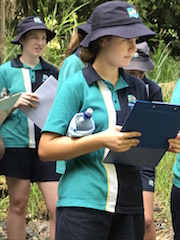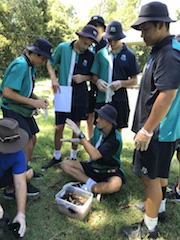 Earlier this term, Year 11 Biology students went on a two-day excursion, visiting Woodfordia and various sites of Petrie Creek. On the first day, we went to an area just outside of Woombye and another in Florabunda where, with our two ECOllaboration instructors, we tested for various water parameters. The tool we used was a Horiba U-50, which can measure 11 parameters simultaneously. At an approximate cost of $6000, we appreciated using the technology currently used by Environmental Project Managers in the field. Due to the fact that one location was upstream and the other downstream, there was a difference in results. We found that Woombye had lower dissolved oxygen, cleaner water, lower turbidity, increased flow and shallower water compared to Florabunda, which was downstream. Our next line of testing involved macroinvertebrates. Stephanie, Layka, Olivia and Georgia put on waders and using a technique referred to as ‘boot scootin’, caught some macroinvertebrates for us to identify and analyse. The biotic data proved that the pollution in the water was very low at Woombye but moderate downstream at Florabunda. One of our last stops for the day was Australia’s largest residential floating wetland
Earlier this term, Year 11 Biology students went on a two-day excursion, visiting Woodfordia and various sites of Petrie Creek. On the first day, we went to an area just outside of Woombye and another in Florabunda where, with our two ECOllaboration instructors, we tested for various water parameters. The tool we used was a Horiba U-50, which can measure 11 parameters simultaneously. At an approximate cost of $6000, we appreciated using the technology currently used by Environmental Project Managers in the field. Due to the fact that one location was upstream and the other downstream, there was a difference in results. We found that Woombye had lower dissolved oxygen, cleaner water, lower turbidity, increased flow and shallower water compared to Florabunda, which was downstream. Our next line of testing involved macroinvertebrates. Stephanie, Layka, Olivia and Georgia put on waders and using a technique referred to as ‘boot scootin’, caught some macroinvertebrates for us to identify and analyse. The biotic data proved that the pollution in the water was very low at Woombye but moderate downstream at Florabunda. One of our last stops for the day was Australia’s largest residential floating wetland  at Parklands II. Here they use the bacteria inoculated root systems of the floating wetlands to filter storm water contaminates that end up in urban bodies of water.
at Parklands II. Here they use the bacteria inoculated root systems of the floating wetlands to filter storm water contaminates that end up in urban bodies of water.
On the second day we started at Woodfordia and learnt about mycelium, which is the vegetative part of fungi, from Dr Sandra Tuszynska. We split into groups and participated in an experiment called Battell, to watch the growth of mycelium, the decomposers of the natural world. We then travelled to Mary Cairn Cross Reserve in Maleny, where we walked through the Rainforest and identified different species of mushrooms growing on decaying and dead matter such as fallen trees.
Dr Sandra Tuszynska spoke to us about mycelium all around the world. She explained how fungi helps to regenerate the Earth and decompose dead matter. There are an estimated 1.5 to 5 million species of fungi yeasts and moulds and we learnt that certain species, including the oyster mushroom, produce enzymes that break down the tough,  aromatic hydrocarbons found in petroleum, in addition to soaking up heavy metals like mercury. The presentation also included a variety of interesting facts about the cellular structure of mycelium and how they use enzymes. In addition, Dr Tuszynska discussed how they are important in the sustainability of forests because plants ‘talk’ to each other via the Wood Wide Web.
aromatic hydrocarbons found in petroleum, in addition to soaking up heavy metals like mercury. The presentation also included a variety of interesting facts about the cellular structure of mycelium and how they use enzymes. In addition, Dr Tuszynska discussed how they are important in the sustainability of forests because plants ‘talk’ to each other via the Wood Wide Web.
Overall, the two-day excursion was a great experience for the whole class, as it built on what we are learning in class and was presented in a fun, interactive and entertaining way. There were many different activities and lessons that will definitely assist us not only this year with our exams but also in our future endeavours.
Joseph Higginson and Rebekah Pierce, Year 11 Biology Students
 We congratulate our STEM team who won the Sunshine Coast Science and Engineering Challenge yesterday at the University of the Sunshine Coast. The Challenge is part of a nationwide STEM outreach program presented by the University of Newcastle in partnership with communities, Rotary clubs, universities and sponsors. Throughout the day, our Year 10 students competed against seven other schools in the region, undertaking various hands-on challenges. This term, our students have been engaged in exciting learning within the STEM area across Mathematics, Science, Design Technology and Information Technology and within our newly instigated Year 9 and 10 STEM courses. We congratulate our students and thank teachers Mrs Marnie Whittaker, Mrs Claire Richards and Mr Wes Warner for their leadership and guidance in this area as well as Miss Rebecca Ross, Mrs Janine Stone, Mr Ian Learoyd and Mr Adam Doyle who contribute to STEM learning as Heads of Departments.
We congratulate our STEM team who won the Sunshine Coast Science and Engineering Challenge yesterday at the University of the Sunshine Coast. The Challenge is part of a nationwide STEM outreach program presented by the University of Newcastle in partnership with communities, Rotary clubs, universities and sponsors. Throughout the day, our Year 10 students competed against seven other schools in the region, undertaking various hands-on challenges. This term, our students have been engaged in exciting learning within the STEM area across Mathematics, Science, Design Technology and Information Technology and within our newly instigated Year 9 and 10 STEM courses. We congratulate our students and thank teachers Mrs Marnie Whittaker, Mrs Claire Richards and Mr Wes Warner for their leadership and guidance in this area as well as Miss Rebecca Ross, Mrs Janine Stone, Mr Ian Learoyd and Mr Adam Doyle who contribute to STEM learning as Heads of Departments. This Friday 16th March, we will celebrate ‘Pacific as a Peace Place’ in recognition of the National Day of Action Against Bullying.
This Friday 16th March, we will celebrate ‘Pacific as a Peace Place’ in recognition of the National Day of Action Against Bullying.  Aloha OCEANfest 2018
Aloha OCEANfest 2018 We warmly welcome Mrs Teena Thompson as our OCEANfest Convenor for 2018. Teena has always given great energy and thoughtfulness to all FoP activities she’s been involved in, including previous OCEANfests. Mrs Tracey Hindmarsh will again support the year level stalls with encouragement and guidance. Our sponsorship team will shortly begin contacting local businesses outlining the promotional opportunities on offer. Sponsorship of OCEANfest 2018 is a unique opportunity to connect with our ever growing and diverse community. Throughout the years of successful OCEANfests, we have forged many successful partnerships that have enabled us to raise funds, support our community and our students’ academic, sporting, social and cultural experiences. Our logistics team have also begun their meticulous planning with a particular focus on the use of space and equipment. To join any of the teams, please email
We warmly welcome Mrs Teena Thompson as our OCEANfest Convenor for 2018. Teena has always given great energy and thoughtfulness to all FoP activities she’s been involved in, including previous OCEANfests. Mrs Tracey Hindmarsh will again support the year level stalls with encouragement and guidance. Our sponsorship team will shortly begin contacting local businesses outlining the promotional opportunities on offer. Sponsorship of OCEANfest 2018 is a unique opportunity to connect with our ever growing and diverse community. Throughout the years of successful OCEANfests, we have forged many successful partnerships that have enabled us to raise funds, support our community and our students’ academic, sporting, social and cultural experiences. Our logistics team have also begun their meticulous planning with a particular focus on the use of space and equipment. To join any of the teams, please email 

 Games This Week
Games This Week Pacific FC Merchandise
Pacific FC Merchandise

 Concertedly Baroque
Concertedly Baroque